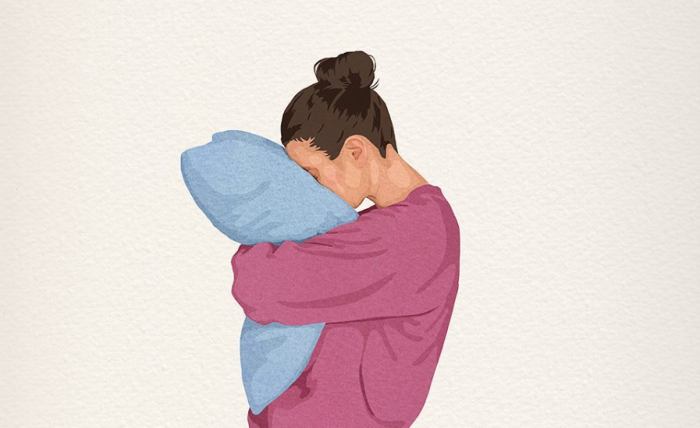This article is written in partnership with Yarlap®—they’re dedicated to helping us enjoy the benefits of better pelvic floor health and we’re honored to work with them. ~ ed.
Did I just squirt, or did I pee? Mood = ruined.
Often, when we talk about pelvic floor health, we talk about the sexy stuff—how proper tone means good sex and better orgasms.
And that’s sometimes very true, but it’s also just the happy surface of pelvic floor topics. And if you’ve ever dealt with pelvic floor probs like stress incontinence, you know that the sexy talk is a privileged approach.
Because beyond oomphless orgasms, there are legitimately serious emotional and physical dark sides to having a weak(er) pelvic floor that we don’t like to talk about.
We don’t talk about the social isolation, the depression, the anxiety. We hide the shame we feel behind chirpy, chuckling surface-y conversations about our “little piddle problem.”
And certainly, we fully avoid sharing about the big puddle that left us feeling muddled at that one family dinner that we never—ever—want to talk about again.
So, let’s take a minute to get real.
Poor pelvic floor tone doesn’t just occlude our orgasms; it can take a wrecking ball to our sexual, mental, and overall physical health.
Dad-and-daughter duo, Brent and MaryEllen Reider, know that incontinence significantly impacts quality of life despite being difficult for folks to disclose. That’s why they designed the Yarlap®, a magic-making Kegel machine designed to tone the pelvic floor, and stop the cause of leaks at its source.
That’s also exactly why, when I read an article about it here on Elephant a while ago, I was eager to give it a try.
I’ve been dealing with what is called stress incontinence for decades. I’ve always had a hard time keeping my pee in when laughing hard, sneezing, or coughing. Whatever; I thought it was normal.
Yarlap® can Help. Use code EJ50 for $50 off >>
But somewhere in my early 30s, I noticed a change. The always-stellar sex I’d had with a longtime sex partner wasn’t as powerful. I chalked it up to losing a bit of the spark and moved on.
Soon, though, even my sexy self-love sessions fell rather lackluster, and that carried over into my partnered romantic life. I was doing my Kegels, but they didn’t seem to be working. Cue the shame and performance anxiety and frustration that I just couldn’t get there like I used to or offer my partner the satisfaction that he’d made it happen.
Not to be dramatic here, but it kinda started to wreck my life.
Because I so badly want to be a mom someday soonish, anything “wrong” down there tends to send me off the deep end of paranoia. This was no different; the anxiety was real. Is this premature aging? Could this indicate other issues that might be going on in my reproductive region?
Because future baby-making involves sexy time, my stress and coital incontinence triggered me there, too. Ugh! Who wants to sleep with a woman who admits to needing to change her tinkled thong? Nowhere else on my body is toned, of course down there wouldn’t be, either. Did I just climax, or did I pee, or both!? Annnnnd, we’re done.
The central fear in all these worries? That I was less of a woman—that I was broken, lacking, undesirable.
Man, that’s some bullsh*t thinking, isn’t it? And it sounds a lot like poor body-image, low self-esteem, and anxiety, huh?
There’s normalization in numbers, so here are a couple of statistics:
Incontinence may not be exactly normal, but we’re also not alone. At all.
One in four women over the age of 35 is affected by incontinence (2) And of that roughly one quarter of us women who deal with it on any level, we are likely to experience mental, physical, sexual, and financial burdens because of it.
Mental Health
Almost three times as many of us with female incontinence have depression compared to our incontinence-free counterparts (3). And the more severe the incontinence, the more severe the depression is likely to be (1).
A huge factor in this is the shame and embarrassment that we tend to carry in regard to our incontinence. We hide it from friends and family, and on average, we take about six years to even speak to a doctor about our little secret.
As we can begin to isolate and hold ourselves back from activities we used to love for fear of having an embarrassing accident, we develop anxiety and other mental health issues that quell our quality of life.
This (Elephant-tested) device can work magic (use code EJ50 for $50 off) >>
Physical Health
Speaking of activity avoidance, over 20% of us women with incontinence have quit physical activities due to urinary incontinence (2).
When we have stress incontinence, which is what I personally deal with, we might avoid physical activity like our high-impact run, or that trip to the gym for fear that the pressure exerted in, say, a dreaded burpee, will trigger a tinkle.
The catch-22 is that as we take on a more sedentary lifestyle, we place ourselves at greater risk for other serious diseases like osteoporosis, hypertension, and coronary heart disease.
Even the small physical side-effects of incontinence have a potentially big impact. Additional moisture where the sun don’t shine might mean painful rashes and even fungal or bacterial infections (hello UTIs and yeast infections, and hello gut-biome-deteriorating antibiotics).
We’re not painting a pretty picture, here.
Sexual Health
Remember how I shared that my sex life struggles and how that was one of the first signs that something—er—deeper was going down?
Up to 50 percent of women with urinary incontinence experienced sexual dysfunction (1). And according to one of Yarlap’s own research papers (4), that makes a lot of sense seeing as the tone of the pelvic floor muscles are directly related to the generation of that undulating, rolling muscular contraction we experience as we climax. If our tone sucks, so might that undulation.
Add to that anatomical disadvantage the anxiety surrounding the possibility of an accidental golden shower during sex, and it’s easy to see why many of us with incontinence might avoid sex all around.
Put a little cherry of negative body image on top of that and you’ve got yourself an icy asexual sundae.
While that’s not necessarily the end of the world, this does begin to affect our partners too, and our overall intimacy and relationships can begin to suffer, further diminishing ours and our loved ones’ quality of life.
For better orgasms, you need a healthy relationship—with your pelvic floor. Here’s the best solution we’ve found (use code EJ50 for $50 off) >>
It’s a nasty trickle-down effect, if you will.
Financial Health
Incontinence due to poor pelvic floor tone doesn’t just take a toll on our mental, physical, and sexual health, it can affect our financial health as well.
Nearly a quarter of women with incontinence take time off of work due to incontinence (1), which in some cases is a heavy burden that can leave our paychecks a little lighter.
But in addition to that potential monetary loss, on an individual level, women with severe urinary incontinence pay, on average, over $900 annually for incontinence care, including things like absorbent products, medications, doctor visits, and dry cleaning or laundry.
It’s safe to say that incontinence, which is often improved or avoided with proper pelvic floor tone, puts a literal drain on almost every facet of our lives as women. And it wouldn’t be too much of a leap to say that we’re peeing away our quality of life when we choose to ignore our pelvic floor health.
We can choose to focus on living with the problem and spend our mental, emotional, physical, and financial resources dealing with something we allow to persist and worsen. We can spend our cash on doctor’s visits and physical therapy copays (which, you really should see a doctor about incontinence, anyway). We can stock up on pads, or even try biofeedback. We can do 1,000 Kegels a day, but they’re only going to work if we do them properly, which a majority of us do not.
Or we can come to—well—grips with our reality and take action to change our tone by focusing on a clinically proven solution that gets to the root chakra of the problem—and strengthens our pelvic floor muscles while reducing the severity of our incontinence and its unfortunate side effects.
Yarlap’s AutoKegel® technology specifically targets and tones the pelvic floor muscles that support our internal organs, ship shapes up our posture, and embraces the muscles that help us have more satisfying sex. And it costs way less than the amount we might spend on our little piddle problem over the next years.
The best part? We don’t have to do a thing. Yarlap® does the heavy lifting of Kegels for us—and does them right.
It’s like a treadmill for your vagina, but with 100% less effort (use code EJ50 for $50 off) >>
Take it from us: it works.
Okay, so I lied: You do have to do something, and in my case that was insert Yarlap®, kick up my feet, take a 20-minute break, and indulge in reading a book, which honestly has felt like a real treat to incorporate into my day. But I could easily do things like wash the dishes or chill on my patio (yep, it’s that discreet).
After a couple of weeks of use, that drip drip running down my inner hip (hey, Imagine Dragons) has significantly reduced, which I was honestly a little surprised to see since I hardly feel anything—just an almost non-existent muscle-jiggling, tingly “vibration” of sorts—going on down there when using the Yarlap®.
I remember sneezing while squatting to get something from a low drawer and thinking, “Thar she blows,” only to be surprised that nothing leaked out when usually I’d be prepared for the shame involved in knowing that a couple drops made it onto the carpeted floor. Not this time!
My Yarlap sessions might have been a bit more of an every other day occurrence up until that point. But ever since then, it’s been a daily date I’m not willing to ditch—a priority in my daily routine.
My only complaint? I wish I’d have known about this sooner. I could have saved myself several years of worry, insecurity, and physical and emotional discomfort.
If we’re serious about our self-care, sex-care, or overall feminine hygiene, I can’t emphasize enough how important it is to make sure we are pampering our pelvic floor.
From an anatomical standpoint, it literally has our back through thick and thin, and supports us in everything from the birthing of babies to the creation of quality climax (see next article, coming soon). And that’s all something we ought to want to invest in.
Strengthen both your pelvic floor—& your orgasms with Kegels done for you (use code EJ50 for $50 off) >>
~
Resources:
1. https://obgyn.onlinelibrary.wiley.com/doi/10.1576/toag.13.3.143.27665
2. https://www.nafc.org/bhealth-blog/the-true-impact-of-incontinence
3. https://www.webmd.com/women/news/20070117/emotional-toll-female-incontinence
4. https://www.scitechnol.com/peer-review/role-of-pelvic-floor-muscles-in-female-orgasmic-response-TwdR.php?article_id=5635
Cover Image: Lany-Jade Mondou/Pexels





Read 0 comments and reply